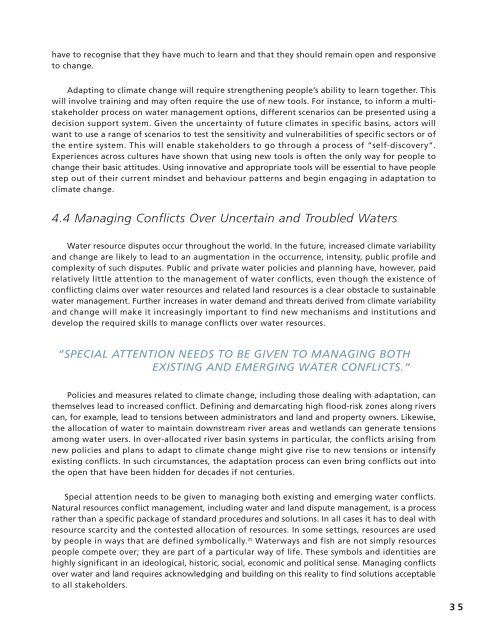Adaptation of water resources management to climate change
Adaptation of water resources management to climate change
Adaptation of water resources management to climate change
Create successful ePaper yourself
Turn your PDF publications into a flip-book with our unique Google optimized e-Paper software.
have <strong>to</strong> recognise that they have much <strong>to</strong> learn and that they should remain open and responsive<strong>to</strong> <strong>change</strong>.Adapting <strong>to</strong> <strong>climate</strong> <strong>change</strong> will require strengthening people’s ability <strong>to</strong> learn <strong>to</strong>gether. Thiswill involve training and may <strong>of</strong>ten require the use <strong>of</strong> new <strong>to</strong>ols. For instance, <strong>to</strong> inform a multistakeholderprocess on <strong>water</strong> <strong>management</strong> options, different scenarios can be presented using adecision support system. Given the uncertainty <strong>of</strong> future <strong>climate</strong>s in specific basins, ac<strong>to</strong>rs willwant <strong>to</strong> use a range <strong>of</strong> scenarios <strong>to</strong> test the sensitivity and vulnerabilities <strong>of</strong> specific sec<strong>to</strong>rs or <strong>of</strong>the entire system. This will enable stakeholders <strong>to</strong> go through a process <strong>of</strong> “self-discovery”.Experiences across cultures have shown that using new <strong>to</strong>ols is <strong>of</strong>ten the only way for people <strong>to</strong><strong>change</strong> their basic attitudes. Using innovative and appropriate <strong>to</strong>ols will be essential <strong>to</strong> have peoplestep out <strong>of</strong> their current mindset and behaviour patterns and begin engaging in adaptation <strong>to</strong><strong>climate</strong> <strong>change</strong>.4.4 Managing Conflicts Over Uncertain and Troubled WatersWater resource disputes occur throughout the world. In the future, increased <strong>climate</strong> variabilityand <strong>change</strong> are likely <strong>to</strong> lead <strong>to</strong> an augmentation in the occurrence, intensity, public pr<strong>of</strong>ile andcomplexity <strong>of</strong> such disputes. Public and private <strong>water</strong> policies and planning have, however, paidrelatively little attention <strong>to</strong> the <strong>management</strong> <strong>of</strong> <strong>water</strong> conflicts, even though the existence <strong>of</strong>conflicting claims over <strong>water</strong> <strong>resources</strong> and related land <strong>resources</strong> is a clear obstacle <strong>to</strong> sustainable<strong>water</strong> <strong>management</strong>. Further increases in <strong>water</strong> demand and threats derived from <strong>climate</strong> variabilityand <strong>change</strong> will make it increasingly important <strong>to</strong> find new mechanisms and institutions anddevelop the required skills <strong>to</strong> manage conflicts over <strong>water</strong> <strong>resources</strong>.“SPECIAL ATTENTION NEEDS TO BE GIVEN TO MANAGING BOTHEXISTING AND EMERGING WATER CONFLICTS.”Policies and measures related <strong>to</strong> <strong>climate</strong> <strong>change</strong>, including those dealing with adaptation, canthemselves lead <strong>to</strong> increased conflict. Defining and demarcating high flood-risk zones along riverscan, for example, lead <strong>to</strong> tensions between administra<strong>to</strong>rs and land and property owners. Likewise,the allocation <strong>of</strong> <strong>water</strong> <strong>to</strong> maintain downstream river areas and wetlands can generate tensionsamong <strong>water</strong> users. In over-allocated river basin systems in particular, the conflicts arising fromnew policies and plans <strong>to</strong> adapt <strong>to</strong> <strong>climate</strong> <strong>change</strong> might give rise <strong>to</strong> new tensions or intensifyexisting conflicts. In such circumstances, the adaptation process can even bring conflicts out in<strong>to</strong>the open that have been hidden for decades if not centuries.Special attention needs <strong>to</strong> be given <strong>to</strong> managing both existing and emerging <strong>water</strong> conflicts.Natural <strong>resources</strong> conflict <strong>management</strong>, including <strong>water</strong> and land dispute <strong>management</strong>, is a processrather than a specific package <strong>of</strong> standard procedures and solutions. In all cases it has <strong>to</strong> deal withresource scarcity and the contested allocation <strong>of</strong> <strong>resources</strong>. In some settings, <strong>resources</strong> are usedby people in ways that are defined symbolically. 35 Waterways and fish are not simply <strong>resources</strong>people compete over; they are part <strong>of</strong> a particular way <strong>of</strong> life. These symbols and identities arehighly significant in an ideological, his<strong>to</strong>ric, social, economic and political sense. Managing conflictsover <strong>water</strong> and land requires acknowledging and building on this reality <strong>to</strong> find solutions acceptable<strong>to</strong> all stakeholders.35











![View full document [PDF 988.55 KB] - PreventionWeb](https://img.yumpu.com/47733942/1/184x260/view-full-document-pdf-98855-kb-preventionweb.jpg?quality=85)
![View full document (in French) [PDF 4.96 MB] - PreventionWeb](https://img.yumpu.com/47223870/1/184x260/view-full-document-in-french-pdf-496-mb-preventionweb.jpg?quality=85)


![View full document [PDF 25.02 MB] - PreventionWeb](https://img.yumpu.com/44204570/1/190x234/view-full-document-pdf-2502-mb-preventionweb.jpg?quality=85)
